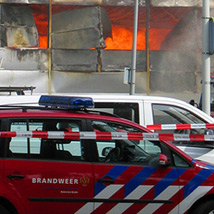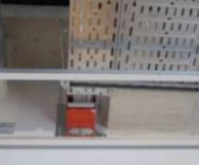Maintaining function in the event of fire
Maintaining function in the event of fire is an essential element of building design. In the event of a fire, the safety installations must continue to operate without disruption for a certain period of time. It is therefore important that both cables and cable management systems (cable trays, cable ducts and ladders) support the installations.

What is firefighting maintenance?
In the event of a fire, it is important that emergency lighting, emergency exit signs and fire alarm systems continue to function reliably for a period of time. The function maintenance systems in the event of fire must allow the function of the electrical installation to be maintained for 30 to 90 minutes during the fire.
The theme of firefighting is still often confusing. There are three distinct concepts:
- Fire resistance
- Insulation maintenance
- Maintaining the function

What is fire resistance?
Fire resistance refers to the resistance of a building in the event of fire (i.e. the resistance of building elements such as floors, walls, roofs and other building materials), flame penetration, thermal insulation and stability. This is indicated by the letter F (e.g. F60 indicates that the construction elements must have a fire resistance of 60 minutes). This is tested according to DIN 4102.

What is insulation maintenance?
Insulation maintenance relates to the resistance of the cable insulation against fire. This has generally been tested in accordance with DIN VDE 0472 Teil 814. The result is usually indicated by the letters FE (FE180 indicates, for example, that the core of the cable is protected for at least 180 minutes against the effects of fire flames).

What is maintenance of function?
Maintaining the function in the event of fire concerns the fire resistance of the electrical installation. Essential parts of the facility that transmit signals to emergency lighting, evacuation facilities, fire alarm systems and other security installations must continue to transmit this signal in the event of a fire for a specified period of time so that persons in the building can safely leave the building.
The cable support system forms a system with the corresponding fixing material and cables. The whole receives a classification after passing the fire test. In the Netherlands, EN 1366-3 and ETA 130993 deal with these issues. The Directive distinguishes between different classes of installations, depending on whether they are to remain operational for 30, 60 or 90 minutes. The directive stipulates that if the cable support system and its suspension are approved for class E30, E60 or E90, any cable with certification may be applied for the retention period in question.
Our systems have been officially tested according to DIN 4102-12 at renowned test institutes in Western Europe. They are therefore suitable for use in installations that have to meet the E30 and E90 classifications. This also assumes that the installation must be suitable for maintaining the function for 30 and 90 minutes respectively.
Ez-path Fire Module
The constant evolution of electrical and data communication installations requires fire retardant solutions that are easy to apply. Legrand introduces EZ-Path, a fireproof solution that meets both the requirements of modern building use and the legal requirements and standards for fire protection.
EZ-Path Functionality
The EZ-Path Fire Module contains a foam that expands from a temperature of 177°C or in direct contact with a flame. In less than one minute, the foam expands 16 times its volume, filling the openings and blocking the passage. The fireproof seal of the wall is restored, preventing the spread of fire: property is protected and evacuation is safe.
The round slats of the modules fit the shape of the cables perfectly. They limit the rate of leakage and muffle disturbing noises. The special design of the modules and the cover plates ensure an unrivalled aesthetic appearance. The color red RAL 3001 corresponds to the color codes of fire-fighting equipment.

Ease of use and maintenance
Unique and easy placement
Reduced intermediate maintenance (no need to plug holes)
Permanent firewall function (even without cable)
Wiring modifications without demolition work
No unnecessary nuisance due to dust and noise
Reusable product
Administrative simplification (invoice control, planning, third party activity control, journal administration)

Thermal insulation
120 minutes thermal insulation (I) according to EN 13501-2:2005 and NEN 6069
Flame-tightness

Flame-tightness
Flame-tightness (E) of 120 minutes according to EN 13501-2:2005 and NEN 6069

Fire resistance for 180 minutes
Fire resistance for 180 minutes (Sa and Sm) according to NEN 6075
Return on investment (ROI)
In practice, the EZ-Path is already damped after the second cable change in a fire-rated bushing.
To find out if the solution is cost-effective for your company, just ask yourself a few questions:
- How much do you pay for caulking a fire penetration?
- How many caulkings do you perform per year?
- Tip: Don't forget the costs of your own staff (administration, planning, etc.).
We can help you establish the ROI (amortization period) for your management: we have designed a specific calculation model.
Invest NOW and benefit from your investment for the next few years!

Maintenance fees
The initial cost consists of placing the EZ-Path and recording it in the logbook. In the event of subsequent modifications, maintenance is very limited by working with a wire puller to easily pass through the cables.
The most important requirement for any building is that it be permanently fire resistant. If the fire compartmentalization is not correct at the time of a fire, the damage is irreparable.
Multi-year maintenance contracts (3 - 30 years)
EZ-Path is ideally suited for multi-year maintenance contracts to minimize maintenance while maintaining fire resistance.
Consider contracts such as :
- PPP: public-private partnership
- DBFM contract (Design, Build, Finance & Maintain)
- PEP: multi-year maintenance plans
Assembly
The installation method depends on the project situation and environment, the type of wall or floor penetration and the wishes of the user or building manager with regard to the planned cabling developments.

General information :
- Identify how the end user wishes to use EZ-Path (for all cables)
- Identify the number and thickness of ropes to determine the number of EZ-Paths per traverse
- Take into account the reserve of future wiring capacity (do not fill an EZ-Path 100%)
- Check the type of wall penetration beforehand to determine the finishing plates.

The goal is to save time, money, and possibly space for the installation of EZ-Path.

Existing cable crossings (renovation) :
Consider sealing the current crossing in the traditional way and creating a reservation with EZ-Path for future cable crossings: saves time.
New cable crossings (new construction/extension):
Determine in advance with the contractor where to install EZ-Path.
For each feedthrough, carefully check the dimensions of the holes to be drilled
Install the EZ-Path system before beginning to install cable support systems. For example, it is recommended that the cable tray be interrupted 5 cm before the EZ-Path module.